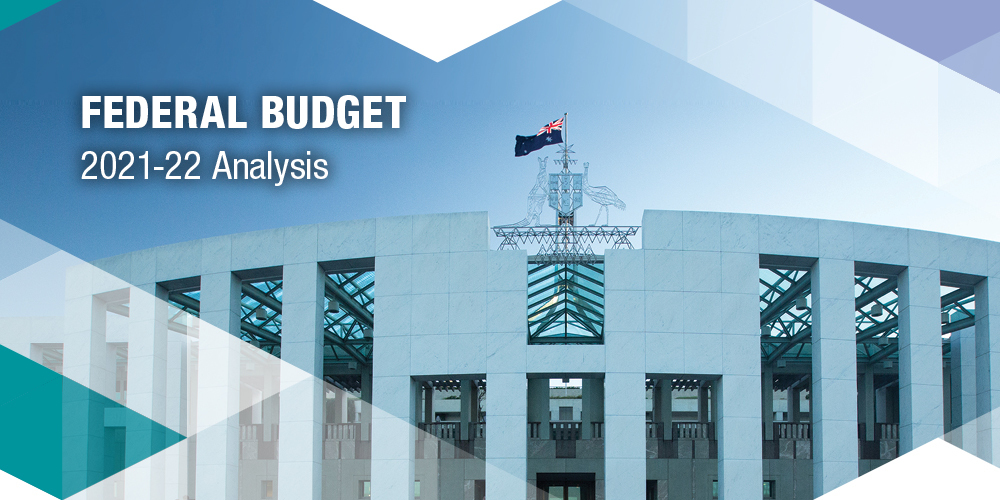Investing in recovery
In his third and possibly last Budget before the next federal election, Treasurer Josh Frydenberg is counting on a new wave of spending to ensure Australia’s economic recovery maintains its momentum.
This budget’s focus is firmly on getting Australia through the pandemic and promoting economic growth and employment. Recent remarks from the Treasurer have made clear that there are still downside risks to the economy and he expects the Government to continue providing a significant amount of support. The budget does this through new spending on priorities like aged care, childcare, and building the digital economy, as well as tax relief for businesses and low income earners.
Some of the key Budget announcements that impact on individuals include:
- the removal of the work test for non-concessional and salary sacrifice contributions
- a reduction in the minimum age requirement for downsizer contributions
- an increase in the amount of voluntary super savings available to first home buyers
- an increase to the childcare subsidy
With the emphasis on spending, balancing the Budget has been put on the back burner until employment and wages pick up.
The big picture
This year’s Budget is based on a successful vaccine rollout which would allow Australia’s borders to open from mid-2022. The Treasurer says he expects all Australians who want to be vaccinated could have two doses by the end of the year.
So far, the economic outlook is better than anyone dared hope at the height of the pandemic just a year ago, but challenges remain.
Unemployment, at 5.6%, has already fallen below pre-pandemic levels and is expected to fall sharply to 5% by mid-2022. But wage growth remains stubbornly low, currently growing at rate of 1.25% and forecast to rise by just 1.5% next year. This is well below inflation which is forecast to rise 3.5% in 2020-21 and 1.75% in 2021-22.
The treasurer forecast a budget deficit of $161 billion this financial year (7.8% of GDP), $52.7 billion less than expected just six months ago, and $106.6 billion (5% of GDP) in 2021-22.
Net debt is forecast to increase to $617.5 billion (30% of GDP) by June this year before peaking at $980.6 billion four years from now. The large improvement in the deficit has been underpinned by the stronger than expected economic recovery and booming iron ore prices.
Superannuation
In regard to superannuation, it is important to note changes previously flagged that were not specifically addressed on budget night:
- The rate of Superannuation Guarantee payable for employees is set to increase from 9.5% to 10% from 1 July 2021
- The temporary measure to halve the minimum pension income draw-down for individuals with an account based pension is set to end, with minimum income requirements reverting back to normal levels from 1 July 2021
- The concessional contribution cap is set to increase to $27,500 from $25,000 presently
- The Non-Concessional contribution cap is set to increase to $110,000 from $100,000 presently
- The Transfer balance cap is set to increase to $1,700,000 from $1,600,000 presently
Expanding the downsizer contributions scheme
The Government has announced it will increase the maximum releasable amount for the First Home Super Saver Scheme (FHSSS) from $30,000 to $50,000.
Housing affordability measures
- An extra 10,000 places on the First Home Loan Deposit Scheme in 2020-21. Now called the New Home Guarantee, the scheme gives loan guarantees to first home buyers, so they can buy a home with a deposit as low as 5%.
- The Family Home Guarantee, intended to allow 10,000 single parents to buy a home with a deposit of just 2%.
- An increase in the maximum voluntary contributions that Australians can release under the First Home Super Saver Scheme from $30,000 to $50,000 (see above for further information).
Other Measures
Removal of Annual Cap: Currently, there is a cap on the amount of Childcare Subsidy a family can receive if their annual family income is more than $189,390 (2020/21). The cap means that no more than $10,560 can be received as a subsidy for each child where a family earns more than this limit. As part of this measure the Government will remove this cap from 1 July 2022.
Approximately ten million Australians will avoid a drop in income of up to $1,080 next financial year, with the low-and-middle-income tax offset extended for another 12 months at a cost of $7.8 billion.
Anyone earning between $37,000 and $126,000 a year will receive some benefit, with people earning between $48,001 and $90,000 to receive the full offset of $1,080.
Temporary Full Expensing Extension: The Government will extend the 2020-21 budget measure for an additional 12 months until 30 June 2023 which allows all businesses with aggregate turnover or total income of less than $5 billion to fully expense depreciable assets in the current tax year.
Other spending measures
Improvements to the Pensions Loan Scheme
After criticism that last year’s Budget did not do enough to support women’s economic engagement, this Budget includes measures aimed at improving gender equity. The Women’s Budget Statement outlines total spending of $3.4 billion on women’s safety, health and economic security measures.
The centrepiece of the Budget is a $17.7 billion commitment over five years to implement key recommendations of the Aged Care Royal Commission. This includes $7.8 billion to reform residential aged care and $6.5 billion for an immediate investment in an additional 80,000 Home Care Packages.
In other health-related initiatives, the Treasurer announced additional funding of $13.2 billion over the next four years for the National Disability Insurance Scheme, taking total funding to $122 billion.
$6.4 billion is being committed to skills training increase workforce participation and help boost economic growth.
Job creation is also at the heart of an extra $15.2 billion in road and rail infrastructure projects, expected to create 30,000 jobs. This is on top of the existing 10-year $110 billion infrastructure spend announced previously.
Looking ahead
With an election due by May 21 next year, this is as much an election Budget as a COVID-recovery one. Although another Budget could be squeezed in before an election, it would have to be brought forward from the normal time.
Information in this article has been sourced from the Budget Speech 2021-22 and Federal Budget support documents.
It is important to note that the policies outlined in this publication are yet to be passed as legislation and therefore may be subject to change.
Authorised Representative | Professional Wealth Services Pty Ltd | PWS ABN: 58 174 609 776 | AFS Licence Number 312047 This advice may not be suitable to you because it contains general advice that has not been tailored to your personal circumstances. Please seek personal financial advice prior to acting on this information. Investment Performance: Past performance is not a reliable guide to future returns as future returns may differ from and be more or less volatile than past returns.























